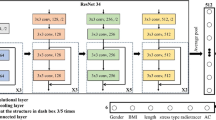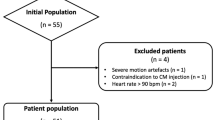Abstract
Purpose
Myocardial perfusion imaging (MPI) using single-photon emission computed tomography (SPECT) is widely used for coronary artery disease (CAD) evaluation. Although attenuation correction is recommended to diminish image artifacts and improve diagnostic accuracy, approximately 3/4ths of clinical MPI worldwide remains non-attenuation-corrected (NAC). In this work, we propose a novel deep learning (DL) algorithm to provide “virtual” DL attenuation–corrected (DLAC) perfusion polar maps solely from NAC data without concurrent computed tomography (CT) imaging or additional scans.
Methods
SPECT MPI studies (N = 11,532) with paired NAC and CTAC images were retrospectively identified. A convolutional neural network–based DL algorithm was developed and trained on half of the population to predict DLAC polar maps from NAC polar maps. Total perfusion deficit (TPD) was evaluated for all polar maps. TPDs from NAC and DLAC polar maps were compared to CTAC TPDs in linear regression analysis. Moreover, receiver-operating characteristic analysis was performed on NAC, CTAC, and DLAC TPDs to predict obstructive CAD as diagnosed from invasive coronary angiography.
Results
DLAC TPDs exhibited significantly improved linear correlation (p < 0.001) with CTAC (R2 = 0.85) compared to NAC vs. CTAC (R2 = 0.68). The diagnostic performance of TPD was also improved with DLAC compared to NAC with an area under the curve (AUC) of 0.827 vs. 0.780 (p = 0.012) with no statistically significant difference between AUC for CTAC and DLAC. At 88% sensitivity, specificity was improved by 18.9% for DLAC and 25.6% for CTAC.
Conclusions
The proposed DL algorithm provided attenuation correction comparable to CTAC without the need for additional scans. Compared to conventional NAC perfusion imaging, DLAC significantly improved diagnostic accuracy.





Similar content being viewed by others
References
Hendel RC, Corbett JR, Cullom SJ, DePuey EG, Garcia EV, Bateman TM. The value and practice of attenuation correction for myocardial perfusion SPECT imaging: a joint position statement from the American Society of Nuclear Cardiology and the Society of Nuclear Medicine. J Nucl Cardiol. 2002;9:135–43.
Ficaro EP, Fessler JA, Shreve PD, Kritzman JN, Rose PA, Corbett JR. Simultaneous transmission/emission myocardial perfusion tomography. Circulation. 1996;93:463–73.
Huang JY, Huang CK, Yen RF, Wu HY, Tu YK, Cheng MF, et al. Diagnostic performance of attenuation-corrected myocardial perfusion imaging for coronary artery disease a systematic review and meta-analysis. J Nucl Med Society of Nuclear Medicine Inc. 2016;57:1893–8.
Hirschfeld CB, Mercuri M, Pascual TNB, Karthikeyan G, Vitola J V, Mahmarian JJ, et al. Worldwide variation in the use of nuclear cardiology camera technology, reconstruction software, and imaging protocols. JACC Cardiovasc Imaging (2021)
Shen D, Wu G, Suk H-I. Deep learning in medical image analysis. Annu Rev Biomed Eng Annual Reviews. 2017;19:221–48.
Litjens G, Kooi T, Bejnordi BE, Setio AAA, Ciompi F, Ghafoorian M, et al. A survey on deep learning in medical image analysis. Med. Image Anal. Elsevier B.V.; (2017) 60–88.
Betancur J, Commandeur F, Motlagh M, Sharir T, Einstein AJ, Bokhari S, et al. Deep learning for prediction of obstructive disease from fast myocardial perfusion SPECT: a multicenter study. JACC Cardiovasc Imaging Elsevier Inc. 2018;11:1654–63.
Yang J, Shi L, Wang R, Miller EJ, Sinusas AJ, Liu CJ, et al. Direct attenuation correction using deep learning for cardiac SPECT: a feasibility study. J Nucl Med. 2021;120:256396 (jnumed).
Shi L, Onofrey JA, Liu H, Liu YH, Liu C. Deep learning-based attenuation map generation for myocardial perfusion SPECT. Eur J Nucl Med Mol Imaging: Springer; 2020.
Géron A Hands-on machine learning with Scikit-Learn and TensorFlow: concepts, tools, and techniques to build intelligent systems. O’Reilly Media (2017)
Dorbala S, Ananthasubramaniam K, Armstrong IS, Chareonthaitawee P, DePuey EG, Einstein AJ, et al. Single photon emission computed tomography (SPECT) myocardial perfusion imaging guidelines: instrumentation, acquisition, processing, and interpretation. J Nucl Cardiol Springer New York LLC. 2018;25:1784–846.
Ficaro EP, Lee BC, Kritzman JN, Corbett JR. Corridor4DM: the Michigan method for quantitative nuclear cardiology. J Nucl Cardiol. 2007;14:455–65.
Dice LR. Measures of the amount of ecologic association between species. Ecology Wiley. 1945;26:297–302.
Slomka PJ, Nishina H, Berman DS, Akincioglu C, Abidov A, Friedman JD, et al. Automated quantification of myocardial perfusion SPECT using simplified normal limits. J Nucl Cardiol. 2005;12:66–77 (No longer published by Elsevier).
Slomka PJ, Fish MB, Lorenzo S, Nishina H, Gerlach J, Berman DS, et al. Simplified normal limits and automated quantitative assessment for attenuation-corrected myocardial perfusion SPECT. J Nucl Cardiol United States. 2006;13:642–51.
Nakazato R, Tamarappoo BK, Kang X, Wolak A, Kite F, Hayes SW, et al. Quantitative upright–supine high-speed SPECT myocardial perfusion imaging for detection of coronary artery disease: correlation with invasive coronary angiography. J Nucl Med. 2010;51:1724 LP – 1731.
Garcia EV, Slomka P, Moody JB, Germano G, Ficaro EP. Quantitative clinical nuclear cardiology, part 1: established applications. J Nucl Med Society of Nuclear Medicine Inc. 2019;60:1507–16.
Goetze S, Wahl RL. Prevalence of misregistration between SPECT and CT for attenuation-corrected myocardial perfusion SPECT. J Nucl Cardiol. 2007;14:200.
Ronneberger O, Fischer P, Brox T. U-Net: convolutional networks for biomedical image segmentation. In: Navab N, Hornegger J, Wells WFA, editors. Med Image Comput Comput Interv – MICCAI 2015 Lect Notes Comput Sci. Springer: Cham; 2015. p. 234–41.
Genders TSS, Steyerberg EW, Hunink MGM, Nieman K, Galema TW, Mollet NR, et al. Prediction model to estimate presence of coronary artery disease: retrospective pooled analysis of existing cohorts. BMJ. BMJ Publishing Group Ltd (2012) 344
DeLong ER, DeLong DM, Clarke-Pearson DL. Comparing the areas under two or more correlated receiver operating characteristic curves: a nonparametric approach. Biometrics JSTOR. 1988;44:837.
McNemar Q. Note on the sampling error of the difference between correlated proportions or percentages. Psychometrika Springer-Verlag. 1947;12:153–7.
Edwards AL. Note on the “correction for continuity” in testing the significance of the difference between correlated proportions. Psychometrika Springer-Verlag. 1948;13:185–7.
Robin X, Turck N, Hainard A, Tiberti N, Lisacek F, Sanchez JC, et al. pROC: an open-source package for R and S+ to analyze and compare ROC curves. BMC Bioinforma 2011 121. BioMed Central. 2011;12:1–8.
Szegedy C, Zaremba W, Sutskever I, Bruna J, Erhan D, Goodfellow I, et al. Intriguing properties of neural networks. 2nd Int Conf Learn Represent ICLR 2014 - Conf Track Proc. ICLR (2014)
Antun V, Renna F, Poon C, Adcock B, Hansen AC On instabilities of deep learning in image reconstruction and the potential costs of AI. Proc Natl Acad Sci. Proceedings of the National Academy of Sciences; (2020) 201907377
Serre T. Deep learning: the good, the bad, and the ugly. Annu Rev Vis Sci Annual Reviews. 2019;5:399–426.
Acknowledgements
The authors thank Ms. Keri M. Hiller, CNMT, RT(N) from the Department of Radiology at University of Michigan Health Systems for her assistance with imaging protocols.
Author information
Authors and Affiliations
Corresponding author
Ethics declarations
Ethics approval
An informed consent waiver was granted by the University of Michigan Institutional Review Board for this retrospective analysis.
Competing interests
T. Hagio, A. Poitrasson-Rivière, J.B. Moody, and J.M. Renaud are employees of INVIA Medical Imaging Solutions. J.M. Renaud is a consultant for Jubilant DraxImage and receives royalties from sales and licensing of FlowQuant. E.P. Ficaro owns stock in INVIA Medical Imaging Solutions. V.L. Murthy is supported by R01AG059729 from the National Institute on Aging, U01DK123013 from the National Institute of Diabetes and Digestive and Kidney Disease, and R01HL136685 from the National Heart, Lung, and Blood Institute as well as the Melvyn Rubenfire Professorship in Preventive Cardiology. Dr. Murthy has received research grants and speaking honoraria from Siemens Medical Imaging. He serves as a scientific advisor for and owns stock options in Ionetix. Dr. Murthy owns stock in General Electric, Cardinal Health and nVidia. He has received expert witness payments on behalf of Jubilant DraxImage and a speaking honorarium from 2Quart Medical. Dr. Murthy receives non-financial research support from INVIA Medical Imaging Solutions.
Additional information
Publisher's note
Springer Nature remains neutral with regard to jurisdictional claims in published maps and institutional affiliations.
This article is part of the Topical Collection on Cardiology
Supplementary Information
Below is the link to the electronic supplementary material.
Rights and permissions
About this article
Cite this article
Hagio, T., Poitrasson-Rivière, A., Moody, J.B. et al. “Virtual” attenuation correction: improving stress myocardial perfusion SPECT imaging using deep learning. Eur J Nucl Med Mol Imaging 49, 3140–3149 (2022). https://doi.org/10.1007/s00259-022-05735-7
Received:
Accepted:
Published:
Issue Date:
DOI: https://doi.org/10.1007/s00259-022-05735-7




